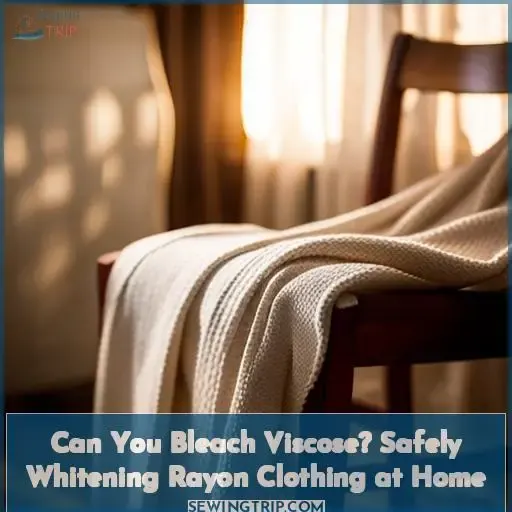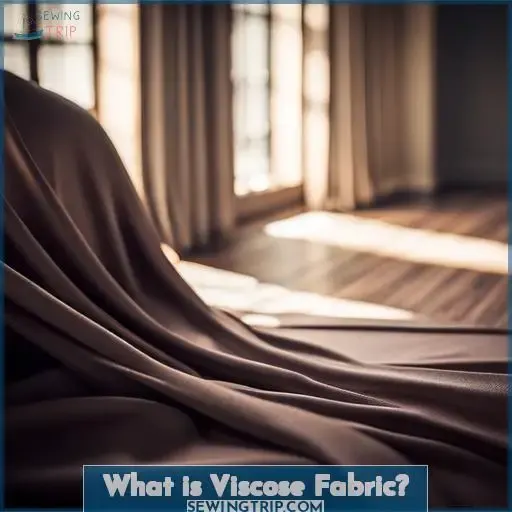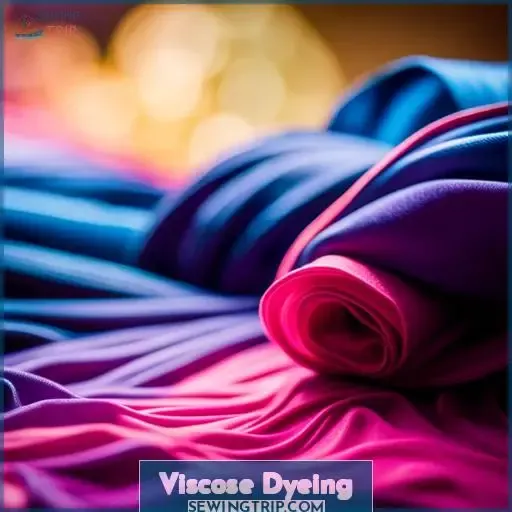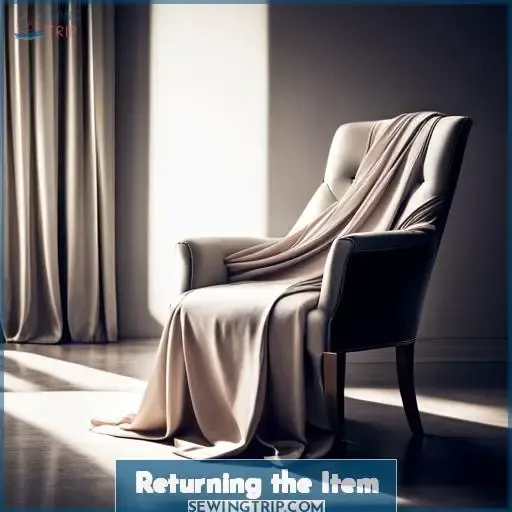This site is supported by our readers. We may earn a commission, at no cost to you, if you purchase through links.
 Viscose’s versatility veils vulnerability.
Viscose’s versatility veils vulnerability.
Before you bleach, be bold, brave, and brilliant.
Bleach breaks bonds, bringing brilliance back, but beware, brutal bleaching blemishes beyond repair.
Bleaching basics begin with brief brand badge button bashing.
Better bag bleach boldly.
But beware, brutal bleaching blemishes beyond repair.
Begin with oxygen options, observing outcomes obsessively.
Table Of Contents
Key Takeaways
- Test oxygen bleach on an inconspicuous area first to check colorfastness before fully bleaching.
- Soak viscose in cool water with oxygen bleach for 30 minutes up to 8 hours, then rinse thoroughly.
- Limit total bleach soaks to avoid weakening viscose fibers.
- Air dry viscose in the shade after bleaching to prevent fading.
What is Viscose Fabric?
**
- Viscose is a type of rayon clothing made from regenerated cellulose fibers.
- It’s delicate yet comfortable to wear.
- As an eco-friendly fabric, viscose requires gentle care.
- Handwashing is recommended to avoid damage.
- Chlorine bleach is unsafe for viscose, but oxygen options may cautiously whiten it.
- Research best practices before attempting to bleach viscose at home.
Bleaching Viscose
When bleaching viscose clothing, use oxygen bleach rather than chlorine bleach.
Test colorfastness first by dabbing diluted oxygen bleach on an inconspicuous area and check for discoloration.
Viscose can become damaged by harsh chlorine bleach, so stick to gentler oxygen formulas for the safest results.
Use Oxygen Bleach
You can bleach viscose, but you should use oxygen bleach rather than chlorine bleach to avoid damaging the fibers.
As textile experts, we know viscose rayon is vulnerable to the harshness of chlorine bleaches.
Opt for gentler oxygen bleach when attempting to revive dingy viscose clothing.
Test colored garments first. Oxygen bleach lifts stains without compromising dyes.
For best home care results, spot test oxygen bleach on an inconspicuous area before full use, following label instructions.
Alternate stain removal techniques may suffice.
Test First
Before bleaching your viscose clothing, test a small, inconspicuous area with diluted oxygen bleach first. This preliminary colorfastness testing allows you to observe test results and take safety precautions before attempting to bleach the entire garment.
If discoloration or damage occurs on the test area, consider bleach alternatives like lemon juice or hydrogen peroxide.
When unsure, consult a laundry expert to verify appropriate oxidizing agents for the viscose fabric.
Viscose Bleaching Instructions
After testing oxygen bleach on an inconspicuous area of your viscose clothing, follow the care label’s recommendations for water temperature when adding the diluted bleach to the washing machine.
- Soak in cool water with 1 tablespoon oxygen bleach per gallon of water for 30 minutes up to 8 hours, depending on the level of discoloration.
- Rinse thoroughly after soaking to remove all bleach residue.
- Air dry in the shade to prevent fading; lay flat initially to retain the garment’s shape.
- Repeat the process if discoloration persists, but limit total soaks to avoid weakening fibers.
- Store cleaned viscose garments folded in breathable, cotton storage containers.
Viscose Dyeing
One challenge you’ll face when dyeing viscose is that it can easily become brittle and break during the process, leading to uneven dyeing that’s difficult to correct.
Viscose fabric, being made from cellulose, is naturally easier to dye compared to synthetic fabrics. However, its delicate nature requires careful handling during the dyeing process.
To avoid damage and achieve desired results, consider colorfastness testing before proceeding with any dyes or bleaching agents on your viscose garments.
In terms of bleach alternatives for lightening viscose clothing, hydrogen peroxide proves safer than chlorine bleach as it’s gentler on the fibers and less likely to cause discoloration or weakening.
When working with this delicate fabric in home care settings such as whitening rayon clothing at home through bleaching or other methods like washing by handwashing loungewear items using cool water along with biodegradable detergents are recommended steps for effective Viscose Fabric Care.
Returning the Item
Regarding the top in question, you don’t have to keep it if it wasn’t accurately represented or doesn’t fit your needs.
eBay’s return policy gives buyers 30 days to send items back for a full refund, including the original shipping costs.
Simply request a return through eBay’s portal to print out a prepaid shipping label.
If kept, consider repurposing the viscose top into yogawear, athletic gear, craft projects like pillows, or donate it.
Carefully vetting product images, descriptions, reviews, and communicating with sellers beforehand helps prevent receiving inaccurate colors.
Accurately representing hues builds trust in transactions.
Repurposing the Top
Instead of returning the top, you’re able to repurpose it for other uses like cutting and sewing it into new styles or using the fabric for crafts projects.
As a textile expert focused on sustainability, I often recommend athletic upcycling of viscose fabrics no longer sparking joy.
That bleached bamboo viscose top could become a breezy yoga transformation with some strategic snipping and stitching.
Or utilize the supple rayon in crafty creations like pillows or totes.
If a DIY fashion project doesn’t call to you, consider donating the garment to charity for reuse, allowing someone else to give it new life.
Repurposing keeps textiles circulating and prevents waste – a small way we can all care for people and planet through mindful choices.
Preventing Future Issues
Leaving dissatisfaction behind, let’s explore how to avoid future mishaps when purchasing viscose garments online.
Carefully reviewing product descriptions and images prior to purchase can prevent unwelcome surprises.
Additionally, 4 key steps can set you up for success:
- Read reviews and check seller ratings to gauge reliability.
- Communicate with the seller beforehand to clarify uncertainties.
- Order fabric samples or swatches to ensure accurate color representation.
- Consider the return policy and customer service reputation.
Staying informed and asking questions empowers you to make the best choices.
By taking proactive measures, you can purchase viscose confidently knowing what to expect when the parcel arrives.
Future online shopping endeavors will be smoother when you approach them consciously and deliberately.
Caring for Viscose Clothing
When caring for viscose garments, focus on:
- Gentle washing
- Air drying
- Avoiding heat
Viscose is easily damaged by:
- Hot water
- Aggressive detergents
- High heat from dryers or irons
Follow the care instructions, test cleaning methods first, and opt for cool water hand washing to safely clean viscose clothing.
Washing
Your care while laundering viscose keeps its softness and shape intact.
Handwash viscose in cool water with a gentle, bleach-free detergent.
Check care labels and test for colorfastness before attempting stain removal.
For brightness without bleach, try an oxygen-based whitener.
Lay flat or hang to dry, keeping the delicate fibers intact.
Drying
You’ll usually want to avoid putting viscose clothes in the dryer to prevent damaging the fibers.
Let viscose air dry instead.
If machine drying is necessary, use a mesh bag for protection. Choose the lowest heat setting and delicate cycle options.
Drape items flat or hang them on a rack to retain shape and prevent shrinkage.
Handling viscose carefully when laundering preserves the fabric’s comfort and longevity.
Frequently Asked Questions (FAQs)
Does viscose shrink when bleached?
Unfortunately, viscose often shrinks significantly when bleached, even when following care label instructions.
The fibers are damaged by bleach, causing them to tighten and lose flexibility.
I’d advise against bleaching viscose unless you’re prepared for potential shrinkage.
Test a small hidden area first to check for colorfastness and shrinkage.
Can I bleach viscose in the washing machine?
Recommend not machine washing any viscose in bleach.
Handwash only using oxygen bleach for light stains.
Chlorine bleach risks damaging viscose fibers.
Is it safe to bleach black viscose?
No. Bleach will damage black viscose fabric’s dyes and fibers.
Even oxygen bleach risks discoloration.
Spot test first.
Handwash in cold water with color-safe detergent instead.
Air dry flat.
How long should I soak viscose in diluted bleach?
Never soak viscose in diluted bleach.
It will damage and disintegrate the fabric.
Instead, use hydrogen peroxide if you must lighten viscose.
Test first.
What percentage of bleach is safe for viscose?
Test on a hidden area first, using no more than 10% bleach diluted in cool water.
Viscose fibers are delicate, so monitor closely and rinse thoroughly to preserve the fabric’s integrity.
Gentleness is key.
Conclusion
Like unraveling a hand-knit sweater, bleaching viscose can damage the delicate fabric beyond repair.
As you care for rayon clothing, handle with care—gentle cycles, air drying, and oxygen bleach only.
Though versatile, viscose is vulnerable.
To keep its vibrant look and soft feel, skip harsh chemicals and instead give extra TLC.
With prevention and precaution, you’ll preserve your favorite pieces for seasons to come.














